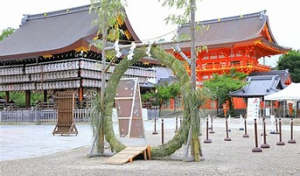Natsukoshi no harae Shrine event in June Chinowa Kuguri
Yoshie Doi

It’s already mid-June this year. Time passes quickly. In Kyoto, on June 30th, “Nagoshi no Harae” and “Chinowa Kuguri” events are held to purify the impurities in the first half of the year and to pray for good health in the second half of the year. It is an event that is held nationwide. It was during the Heian period that the June and December oharae were called “nagoshi no harae”, and December was named “toshikoshi no harae”. The Taiho Ritsuryo Code (701) officially stipulates it as an annual event of the imperial court.
The fact that the events of the imperial court spread to the common people and have become established as an event today means that Japanese values reset their minds and bodies according to the four seasons.
For Kyoto, it is a familiar event, but there are 55,000 convenience stores throughout Japan, but there are 88,000 shrines. Actually, there are more than convenience stores. Many shrines hold seasonal events.
It is often said that “if we want to see the essence, look behind the scenes”, but “Chinowa Kuguri” is an event held once every six months to reset the mind and body. Isn’t it a stage setting for the reset method that has taken root in Japan since ancient times?
The stage setting is the “chinowa kuguri” of the shrine,
“Chinowa Kuguri” is a great way to prepare your body for summer and cleanse your mind.
This is a sacred ritual, but this kind of reset is important for the next step.
In Japan, 8 million people visit shrines during the New Year holidays. Participant in the world’s largest religious event. It is not certain how many people in Japan participate in “Chinowa Kuguri”, but it is a country where many people visit shrines.
The year-end cleaning to welcome the New Year was also a preparation for welcoming the new year. Its roots are in the annual ritual of sweeping the ceilings of shrines and temples and Buddha statues with a bamboo broom called “Susuharai”. Although it is still practiced today, it was originally a custom to exorcise impurities in order to welcome Toshigami.
It is said that the custom of cleaning was established in the Nara period. It seems that the broom was used in religious ceremonies to purify impurities. Today, electric vacuum cleaners are very popular, and some people may not use a broom, but I use a broom every morning to clean the entrance and roads. I find it very useful. The sight of the dust and grime visibly disappearing is important, but in order to sweep my heart with a broom, I always want to wash away the dust with a shower of gratitude and spend time with a smile.
The end of document
